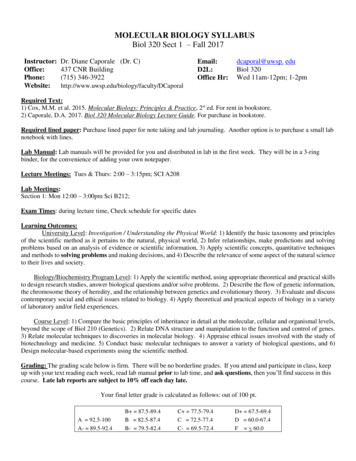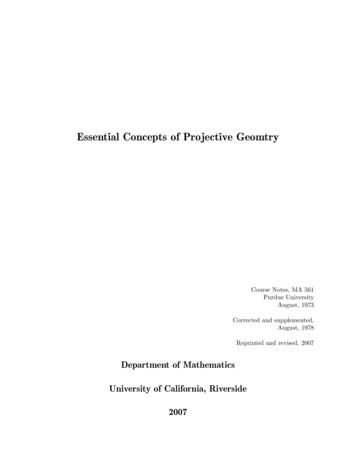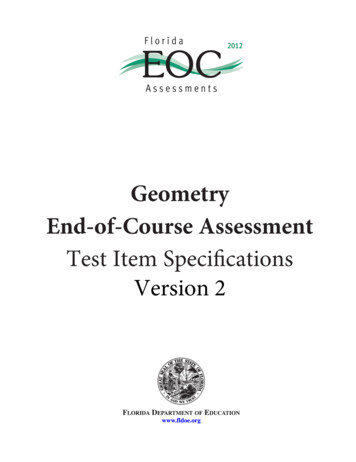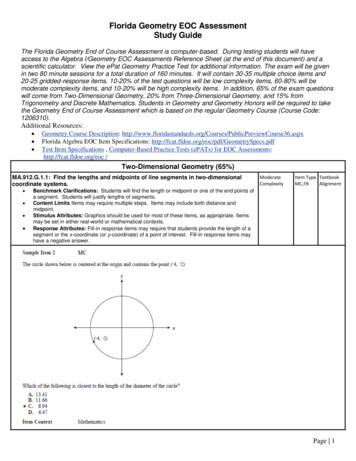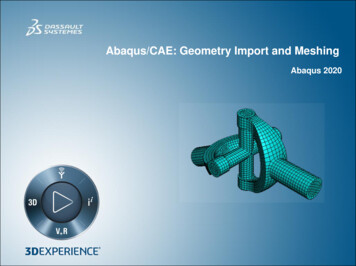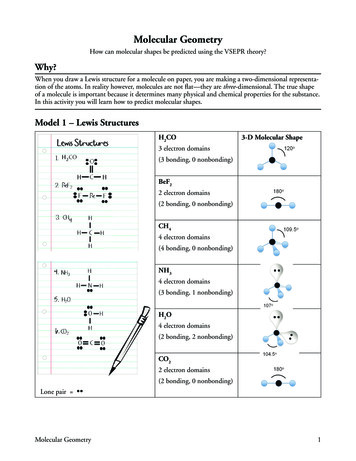
Transcription
Molecular GeometryHow can molecular shapes be predicted using the VSEPR theory?Why?When you draw a Lewis structure for a molecule on paper, you are making a two-dimensional representation of the atoms. In reality however, molecules are not flat—they are three-dimensional. The true shapeof a molecule is important because it determines many physical and chemical properties for the substance.In this activity you will learn how to predict molecular shapes.Model 1 – Lewis StructuresH2CO3-D Molecular Shape3 electron domains(3 bonding, 0 nonbonding)BeF22 electron domains(2 bonding, 0 nonbonding)CH44 electron domains(4 bonding, 0 nonbonding)NH34 electron domains(3 bonding, 1 nonbonding)H2O4 electron domains(2 bonding, 2 nonbonding)CO22 electron domains(2 bonding, 0 nonbonding)Lone pair Molecular Geometry1
1. Name the type of structures shown in the left-hand column of Model 1.2. Examine the drawings in Model 1.a. What does a solid line between two element symbols represent in the drawings of the molecules?b. What subatomic particles (protons, neutrons or electrons) make up these solid lines?c. What does a pair of dots represent in the drawing of the molecules?d. What subatomic particle (protons, neutrons or electrons) makes up each dot?3. What is a lone pair?4. Which molecules in Model 1 have four electron domains? (notice it tells you this in the chart)5. Which molecules in Model 1 have two electron domains?6. Which molecule in Model 1 has three electron domains?7. When determining the number of electron domains in a Lewis structure, which of the followingshould you count? Find evidence from Model 1 to support your answers.a. Bonds on the center atomb. Lone pairs on the center atomc. Total number of atoms in the moleculed. Lone pairs on peripheral atoms8. When determining the number of electron domains in a Lewis structure, do you count doublebonds as one domain or two domains? Find evidence to support your answer from Model 1.2POGIL Activities for High School Chemistry
9. Explain the difference between a bonding electron domain and a nonbonding electrondomain using the examples in Model 1.10. Circle the correct word or phrase to complete the sentences:Pairs of electrons will (attract/repel) each other.Two bonds on the same atom will try to get as (close to/far from) each other as possible.A lone pair of electrons and a bonded pair of electrons will (push away from/move toward) eachother.Read This!The VSEPR (Valence Shell Electron Pair Repulsion) Theory helps predict the shapes of molecules andis based on the premise that electrons around a central atom repel each other. Electron domains are areasof high electron density such as bonds (single, double or triple) and lone-pairs of electrons. In simpleterms VSEPR means that all electron bonding domains and electron nonbonding domains around acentral atom need to be positioned as far apart as possible in three-dimensional space.11. VSEPR theory specifies “valence shell” electrons. Explain why these are the most critical electronsfor determining molecular shape based on your exploration of Model 1.12. In the VSEPR theory, what is repelling what?13. Look at Model 1 and notice how the shapes below line up with specific lewis structuresLinearTrigonal planarPyramidalBentThree-DimensionalMolecular ShapesTetrahedralMolecular Geometry3
14. Often we draw Lewis structures with 90 bond angles. Do any of the molecular shapes inModel 1 have 90 bond angles?15. Which shape was used twice in Model 1? What do the two Lewis Structures have in commonthat cause them to be the same shape?16. Why is CO2 linear while H2O is bent when they have the same number of atoms bonded tothe central atom?17. Identify the three molecules shown in Model 1 that have four electron domains each.a. What happens to the size of the bond angle(s) in a molecule as the number of lone pairs onthe central atom increases?b. Write an explanation for the trend in part a.18. A student does not “waste” his time drawing a Lewis structure before determining the shape ofPF3. The student thinks that the shape of PF3 must be trigonal planar because there are threefluorine atoms bonded to the central phosphorus atom.a. Draw the Lewis structure for PF3.b. Was the student’s answer for the shape of a PF3 molecule correct? Explain.c. Why is it important to draw the Lewis structure for a molecule before identifying the shape ofthe molecule?4POGIL Activities for High School Chemistry
19. Complete the following chart:MoleculeLewis Structure3-D DrawingName of3-D ShapeH2SPH3CCl4CS2Extension Question20. Ozone, O3, is not a linear molecule. Actually it is bent with an angle that is a little less than 120 .a. Draw the Lewis structure of ozone, O3.b. Describe why ozone has a bent shape instead of a linear shape.Molecular Geometry5
of high electron density such as bonds (single, double or triple) and lone-pairs of electrons. In simple terms VSEPR means that all electron bonding domains and electron nonbonding domains around a central atom need to be positioned as far apart as possible in three-dimensional space. 11. VSEPR theory specifies "valence shell" electrons.
